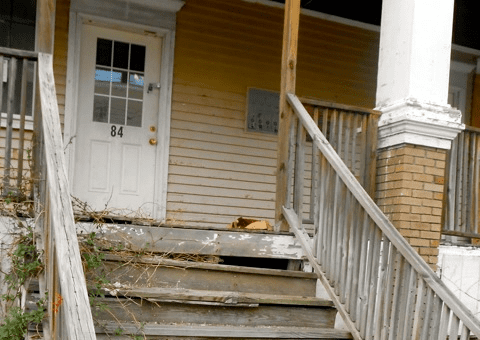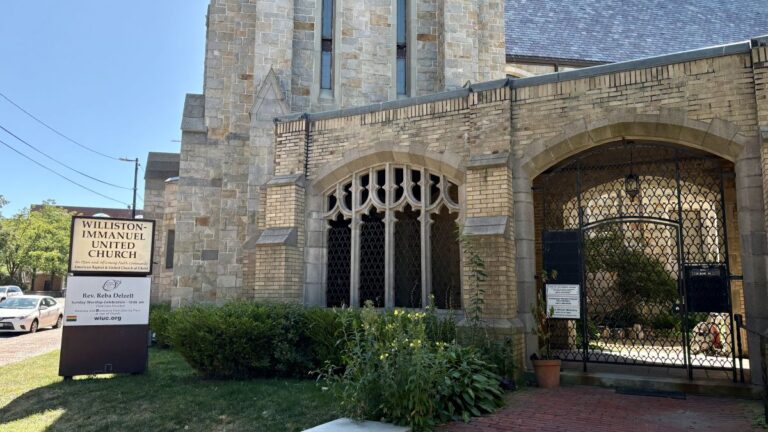On Nov. 15, 1999, Sen. Susan Collins called to order a special Senate committee meeting in Lewiston City Hall.
The Senate Subcommittee on Public Health had traveled to Maine to examine, Collins said, “the serious impact” of lead poisoning on children.

At the time, childhood lead poisoning was on its way to becoming an old and forgotten problem in the nation’s mind. It had been little more than 20 years since federal law had banned lead in paint and reduced the lead in gasoline, and victory had been declared in the fight against toxic lead.
But on block after block around Lewiston City Hall and just across the river in Auburn, the silent poison still lurked in the chipping and peeling paint in decaying tenement buildings and dilapidated apartments.
Collins was aware how the fight against childhood lead poisoning had stalled.
She told the gathering of officials, witnesses and the public that the country was “making little progress … in eliminating the major source of childhood lead poisoning today, lead-based paint from older housing.”
She heard from mothers of lead-poisoned children how their childrens’ lives had been altered, how they had felt powerless to help and how the state and federal governments offered too little education and money to deal with the problem.
Sixteen years later, the battered residential buildings of downtown Lewiston and Auburn still provide stark testament that the war on childhood lead poisoning has not yet been won.
Between 2009 and 2014, there were 467 children identified as lead poisoned in the entire state of Maine and 97 of those children were from the Lewiston-Auburn area.
While the state’s public health efforts to fight childhood lead poisoning have been more successful in the cities of Bangor, Portland, Saco, Biddeford and Sanford, where the rates of lead poisoning have gone down dramatically in the past 20 years, the rates of childhood lead poisoning in Lewiston and Auburn remain stubbornly high — three times the rate of the rest of state.
And because so few children have historically been screened for lead poisoning in the Lewiston-Auburn area, the rate may be even higher than that.
Lead poisoning’s effects have come to particularly plague the children of Lewiston and Auburn’s poor families and the cities’ largely Somali immigrant population, because those groups comprise a high percentage of the tenants living in the lead-infested downtown rental apartments.
The tragedy is that the disease of lead poisoning — “this blunter of children’s cognition and silent thief of their futures,” in the words of pioneering researchers Drs. Herbert Needleman and Richard Jackson — is preventable. But until it is eradicated, it is damaging many Lewiston and Auburn children, afflicting them with lowered intelligence, lifelong behavior or attention problems, hearing deficiencies, kidney damage and slowed body growth.
Not worth it for landlords
The efforts to diminish lead poisoning in Lewiston and Auburn have faced one immutable fact: Many of the often-absentee landlords whose buildings have been poisoning children don’t have or want to spend the money to fix the problem, even if government grants cover 90 percent of the cost.

State grants have been awarded to groups in Lewiston-Auburn to educate landlords about lead paint hazards. Staff at state and local agencies offer to work with landlords to help them obtain government funds to fix problems. But those staff say it’s often difficult, if not impossible, to get landlords to work with them.
“In Lewiston, where 70% of landlords live outside the city, outreach and education to landlords is often challenging,” wrote staffers at Healthy Androscoggin in a report to the John T. Gorman Foundation.
“Some landlords are telling other landlords that lead hazards are not that big of a problem and that they are caused by tenants, thus landlords hold no responsibility,” a Healthy Androscoggin report to the state said. In another report to the state, Healthy Androscoggin staffers said they had sent a tip sheet on lead poisoning to 1,500 Lewiston-Auburn landlords and only two landlords requested more information.
Jayne Jochem, who administers the two cities’ $3.4 million federal grant that provides landlords with money to fix lead contamination, said landlords seem fearful of opening a Pandora’s Box.
“They’re afraid to enroll … in the (lead) program because there could be a code issue” in their buildings as well as lead problems, said Jochem.
Code violations discovered during the required lead inspections need to be repaired, adding to the expense. That scares off landlords, said Jochem.
“I don’t know how many times we go knock on a landlord’s door, we have an abatement order, but they know nothing about the program, it sometimes takes a lot of talking to get them to understand there is help out there and we’re not there to take the building and empty it out,” said Kevin Olson, who works with the Lewiston-based Community Concepts agency, which does lead inspections and abatement throughout Maine.
“I’ve met with landlord organizations all over the state, but actually we’ve never been invited to the Lewiston-Auburn group,” adds Olson. “They don’t want to know.”
“It scares them to think that we might come in and all of a sudden think they can’t rent their building,” said Sandy Albert, who runs the Community Concepts lead program.
The landlords face a simple money problem: There’s a glut of rental housing in the cities’ downtowns, and the rents for their apartments are consequently very low — $500 for a one-bedroom, for example.
With buildings worth very little and maintenance expenses high, “the numbers just don’t work” for landlords who have to spend $7,000 or more per unit to fix the lead problem, said Gil Arsenault, Lewiston’s Director of Planning and Code Enforcement. “It’s a tough, tough business.”
In the last three years, Arsenault said the city has had to demolish “about 75 buildings” that owners walked away from rather than fix up.

Several landlords with multiple apartments in the Lewiston-Auburn area did not return phone calls. But Darcy Reed, whose family owns 36 units in Lewiston, did. And she had a “main message” she wanted to get across:
“Landlords do want to improve their buildings. I think most of them would love to have their buildings abated for lead, like to have (them) be bug free, new siding — but the money just isn’t there,” she said.
And Reed blamed some tenants for their children’s lead poisoning.
“My question is how much is a tenant responsible for,” she asked. “How much is their job to not have their kids eating chipped paint, to ensure that things are cleaned up?
“It’s easy for people to say ‘blame the landlords and they need to fix the problem.’ Nobody wants to say what should the tenants be doing. The reality of it is a lot of those kids downtown are not being taken care of as well as they should be. I see it and it’s sad,” she said.
Creative thinking got federal grant
The $3.4 million federal grant is the result of an effort to alter how the two central Maine cities fight lead poisoning.
Leaders of the effort made two fundamental changes to the way they approached the problem: one, coordination among groups rather than carving off narrow focus areas; and two, a work plan that was broader than fixing only the lead problem.
There were 14 groups in the coalition, whose purpose was formalized in the 2014 Green & Healthy Homes Initiative Compact, and their work was backed by one of the state’s largest foundations.
Nicole Witherbee, chief program officer at the John T. Gorman Foundation, said the foundation’s focus on helping young Maine children do well in school drove their involvement.
“They’re not going to read at grade level if they’re poisoned,” she said.
The coalition crafted a proposal to the federal government that included cleaning up the lead, weatherizing and improving unsafe conditions in downtown rental housing and helping educate area residents, including immigrant families, about the risks lead posed.
“We threw everything we had at it,” said Lewiston City Administrator Ed Barrett.
‘Write that up’
Toxicologist Dr. Andrew Smith, who supervises the state’s childhood lead poisoning prevention program, said his agency can’t solve the problem on its own. There’s a role, said Smith, for municipal code enforcement to play that it hasn’t so far played.
“More work by local code enforcement through visual inspections could potentially do more to prevent exposure to lead,” said Smith.

That’s just what’s happening in one city — Lewiston.
Most cities in Maine don’t have their own property maintenance codes. Lewiston has adopted the International Property Maintenance Code for the purpose of setting “minimum standards to safeguard life or limb, health, property, and public welfare.”
So while code enforcement officers in most Maine municipalities have no legal authority to cite landlords for lead paint, Lewiston’s inspectors do.
‘If we see flaking interior paint,” said Arsenault, “we will write that up.”
The ability to “write that up” means inspectors can prevent lead poisoning before it happens, or gets worse. And in Lewiston, it’s also led to demolition of buildings.
“If we cite and there’s no action, we have to go to court,” said Arsenault. “Our guys will condemn, which is a tool you need in your community. You’re not doing your job if you don’t have this in your community.”
Lewiston Code Enforcement Officer Jeff Baril said, “We’ve taken an approach that probably most communities haven’t, but we have the highest lead poisoning rates in the state….It just came to the point that we’re getting aggressive, but use a little balance.
“Is it an easy process? Absolutely not,” Baril said. “It gets ugly some times. The political will has got to be there and your politicians have to be with you.”
In the end, the federal grant made in 2014 to Lewiston-Auburn will pay to address lead hazards in only 225 housing units. There remain an estimated 16,400 units in those cities, built before 1978, that threaten to poison children with lead.
It would take a lot more than $3.4 million to get the lead out of those units.
“The reality is we don’t have a gazillion dollars,” said Lewiston City Administrator Ed Barrett. “ … so we have to find ways to work with people, educating property owners and tenants so that they take the steps they need to take to protect the kids in those properties.”
Those steps have traditionally been defined as cleaning up the lead dust by dusting and mopping. Yet studies have shown that teaching people to live with lead “safely” is just a partial fix. Those efforts are only effective when done along with lead remediation and removal.
“We know dust control can be valuable, but unless you have extensive cleaning on a regular basis, or lead interim controls, dust control is insufficient,” said Dr. Bruce Lanphear, an expert on childhood lead poisoning, and health sciences professor at Simon Fraser University in British Columbia.
“We can’t rely on passing out mop buckets, or brochures or pamphlets or cleaning rags,” Lamphear said. “It doesn’t work.”

The research and writing of this story was supported by a grant from the Emanuel and Pauline A. Lerner Foundation. This was the final story in a four-part series.







